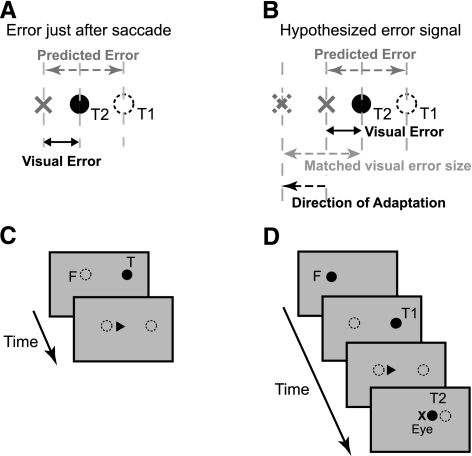Fig. 1.
Experiment design. A: hypothetical visual errors and predicted (expected) errors during constant-error adaptation trials as experienced by the motor system at the conclusion of the primary saccade, assuming that subjects make hypometric saccades. The predicted error is the retinal distance between the saccade end point and the target that the motor system expects to observe at the end of the movement, whereas the visual error is the actual retinal error observed as a result of displacing the target during the trial. T1, primary target; T2, secondary target; X, saccade end point. B: hypothesis for computing the adaptation error signal for a single trial based on the predicted saccade end point. For the visual error to match the size of the predicted error from A (that is, the difference between the observed error and predicted error is zero), the saccade should have been smaller (dashed X); thus, on the next trial saccade gain should become smaller (gain-decrease adaptation) even though both the visual error and the motor correction are directed in the positive (forward) direction. Note that the predicted error is not necessarily the same on every trial. C: target sequence for open-loop trials. Each trial began with a fixation point (F) at the current eye position. After a variable delay (1–2 s), a target (T) appeared 20° away and was extinguished at the onset of the saccade. D: target sequence for constant-error adaptation trials. A fixation point (F) appeared at the current eye position. After a variable delay (1–2 s), the target jumped 20° away (T1) but was extinguished upon saccade onset. When the primary saccade concluded, the jumped target (T2) was placed relative to the saccade end point (X, eye) such that the saccade remained hypometric but the visual error was modified.

